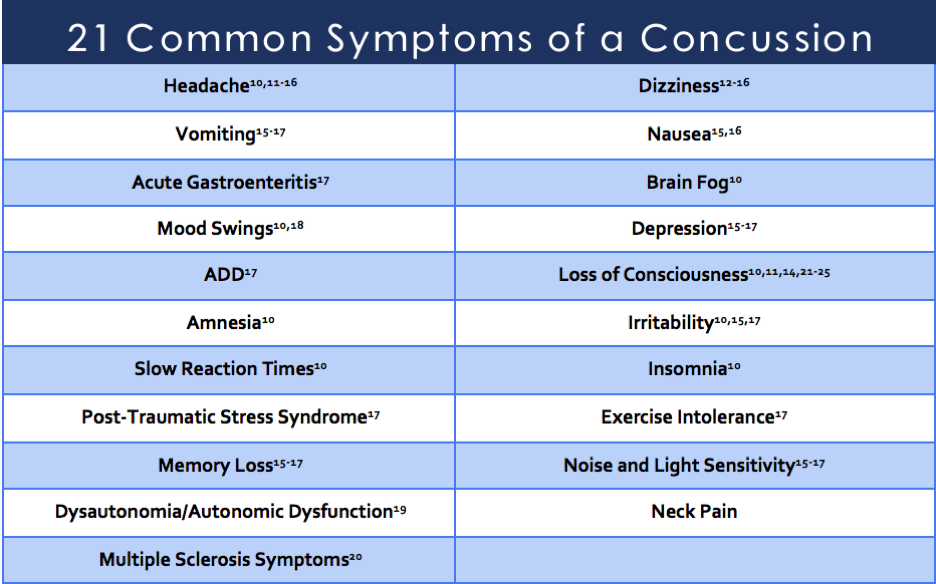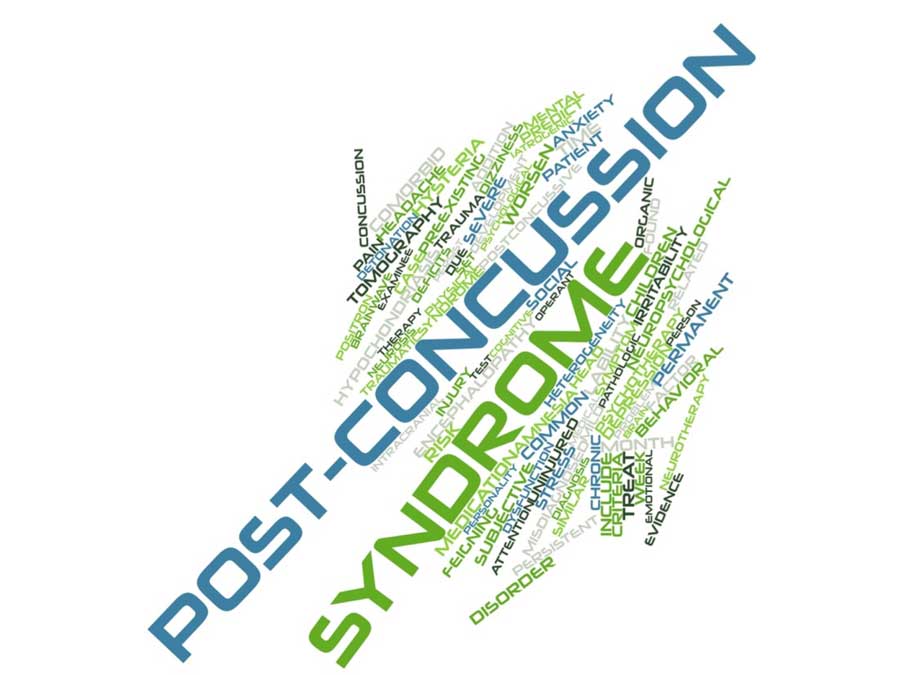Post Concussion Syndrome
There has recently been a rise in concussions, as a result, and a rise in post-concussion syndrome. The long term side effects of a concussion are debilitating once they are revealed. Approximately 225,000 people each year show long-term deficits from traumatic brain injuries which is roughly equal to the number of people diagnosed annually with breast cancer, multiple sclerosis, and traumatic spinal cord injuries COMBINED! This is why it is so important to get checked for spinal misalignments after someone receives a concussion.
About Post Concussion Syndrome
This is a more prevalent diagnosis which has become more prominent because of the media in the past decade and it is still not fully understood, besides the fact that someone may still be experiencing symptoms from the concussion. It is important to note that anything labeled as a syndrome, means that a person is displaying a certain collection of symptoms, not necessarily the underlying problem. Post-concussion syndrome is when symptoms associated with the concussion last longer than 3 months.8,9
What is Chronic Traumatic Encephalopathy?
Chronic traumatic encephalopathy is a degenerative brain disease that is prevalent in people who have experienced multiple brain injuries. It is the result of repetitive brain trauma over many years that causes tau proteins to accumulate in the brain, which interferes with the nerve impulses being sent in the brain. The only way this condition can be diagnosed is looking at brain tissue under a microscope after death.1-5
Today’s society is very symptom based when we really need to be focusing on how our bodies are functioning. The better our bodies function, the less room there is for dysfunction and disease to occur. Chronic neurocognitive impairment after a head injury may be present with symptoms, but can also occur several years later even though no symptoms were present prior!6 This suggests there are problems and dysfunctions in the body that are going undetected for many years eventually get worse over time and then lead to symptoms.

Most people do not consider chiropractic an alternative to help with correcting the root cause of some of the symptoms often associated with a concussion. By aligning the spine, signals are allowed to flow from the brain to the tissues, organs, and muscles of the body so the brain can communicate properly with the body. Adjusting the spine can also improve stimulus, increase blood flow, and increase cerebrospinal fluid to the brain to speed up the healing process during recovery.
Resources:
- McKee AC, Cantu RC, Nowinski CJ, et al. Chronic traumatic encephalopathy in athletes: progressive tauopathy after repetitive head injury. J Neuropathol Exp Neurol 2009;68:709–35.
- Omalu BI, Bailes J, Hammers JL, et al. Chronic traumatic encephalopathy, suicides 211 and parasuicides in professional American athletes: the role of the forensic pathologist. Am J Forensic Med Pathol 2010;31:130–2.
- Omalu BI, DeKosky ST, Minster RL, et al. Chronic traumatic encephalopathy in a national football league player. Neurosurgery 2005;57:128–34; discussion 128– 213, 214.
- Omalu BI, Fitzsimmons RP, Hammers J, et al. Chronic traumatic encephalopathy 214 in a professional American wrestler. J Forensic Nurs 2010;6:130–6.
- Omalu BI, Hamilton RL, Kamboh MI, et al. Chronic traumatic encephalopathy (CTE) in a national football league player: case report and emerging medicolegal 215 practice questions. J Forensic Nurs 2010;6:40–6.
- Harmon K, Drezner J, Gammons M, et al. American medical society for sports medicine position statement: concussion in sport. Clin J Sport Med. 2013;23:1-18.
- Meaney D, Smith D. Biomechanics of Concussion. Clin Sports Med. 2011;30(1):1-12
- Kushner D, Mild traumatic brain injury: Toward understanding manifestations and treatment. Arch. Inter. Med. 1998;158:1617
- Alexander MP, Mild traumatic brain injury: Pathophysiology, natural history, and clinical management. Neurology. 1995;45:1253-1260.
- McCrory P, Meeuwisse W, Aubry M, et al. Consensus statement on concussion in sport: the 4th international conference on concussion in sport held in Zurich, November 2012
- Meehan WP III, d’Hemecourt P, Comstock RD. High school concussions in the 2008-2009 academic year: mechanism, symptoms, and management. Am J Sports Med. 2010;38:2405-2409.
- Marar M, McIlvain NM, Fields SK, et al. Epidemiology of concussions among United States high school athletes in 20 sports. Am J Sports Med. 2012;40:747-755.
- Makdissi M, Darby D, Maruff P, et al. Natural history of concussion in sport: markers of severity and implications for management. Am J Sports Med. 2010;38:464-471
- Benson BW, Hamilton GM, Meeuwisse WH, et al. Is protective equipment useful in preventing concussion? A systematic review of the literature. Br J sports Med. 2009;43:56-67
- Kushner D, Mild traumatic brain injury: Toward understanding manifestations and treatment. Arch. Inter. Med. 1998;158:1617
- Alexander MP, Mild traumatic brain injury: Pathophysiology, natural history, and clinical management. Neurology. 1995;45:1253-1260
- Harmon K, Drezner J, Gammons M, et al. American medical society for sports medicine position statement: concussion in sport. Clin J Sport Med. 2013;23:1-18.
- Busch CR, Alpern HP. Depression after mild traumatic brain injury: a review of current research. Neuropsychol Rev 1998;8:95–108.
- Esterov D, Greenwald B. Autonomic Dysfunction after mild traumatic brain injury. Brain sci. 2017;11:1-8
- Montgomery S, et al. Concussion in adolescence and risk of multiple sclerosis. Ann Neurol. http://dx.doi.org/10.1002/ana.25036
- McCrory P, Meeuwisse W, Johnston K, et al. consensus statement on concussion in sport, 3rd International Conference on Concussion in sport held in Zurich, November 2008. Br J Sports Med. 2009;43:76-90
- Collins MW, Iverson GL, Lovell MR, et al. On-field predictors of neurophysiological and symptom deficit following sports-related concussion. Clin J Sport Med. 2003;13:222-229
- McCrea M, Barr WB, Guskiewicz K, et al. Standard regression-based methods for measuring recovery after sport-related concussion. J Int Neuropsychol Soc. 2005;11:58-69
- McCrory P. Refshauge lecture. When to retire after concussion? J sci Med sport. 2002;5:169-182
- Mansell JL, Tierney RT, Higgins M, et al. Concussive signs and symptoms following head impacts in collegiate athletes. Brain Inj. 2010;24:1070-1074.

